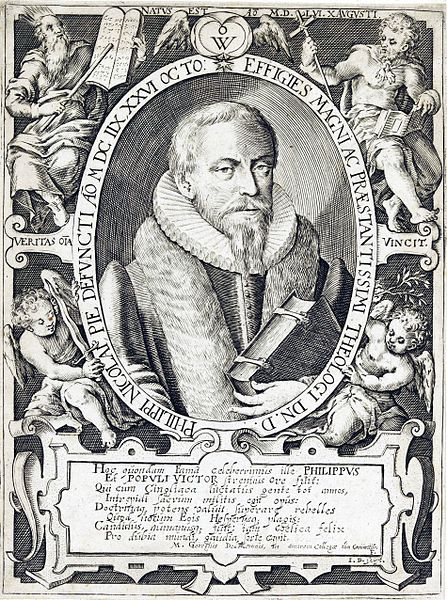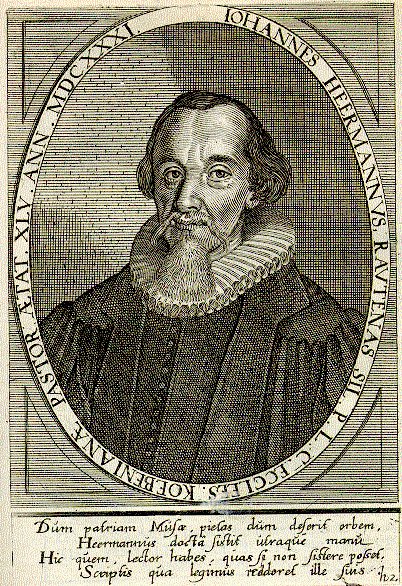
The Great Lutheran Hymnwriters
The great Lutheran hymnwriters, Ss. Nicolai, Heermann, and Gerhardt lived in the sixteenth and seventeenth century, helping steer the Lutheran Church and its confession of faith during some of the most transitional and pivotal years of its existence.
Saint Philipp Nicolai

Philipp Nicolai was born on August 10, 1556 in modern-day Hesse, Germany. His father was a pastor, one of the first in the Lutheran Church. In 1583 he himself became a pastor, serving in multiple locations and earning many degrees throughout his life. In 1596, Nicolai became the pastor of a congregation in Westphalia, but 1597 and 1598 brought the plague, taking 1,300 of his parishioners, sometimes killing as many as 30 a day, 300 over the course of one month, or 170 in one week, as occurred in August of 1597.
In the midst of this sorrow, Nicolai wrote a series of meditations, Mirror of Joy, in which he included two chorales—“Wake, Awake, for Night is Flying,” (LSB 516) and “O Morning Stair, How Fair and Bright” (LSB 395). Known as the “king of chorales” and the “queen of chorales,” respectively, these pieces soon were regarded as favorites across Germany, solidifying Nicolai’s hymnwriting fame.
Throughout his service was called a “second Chrysostom” for his pronounced and powerful teaching and was also remembered for writing a two-volumn biblical apocalyptic work on the kingdom of Christ as well as numerous polemical writings. He died on October 26th, giving us the day on which we remember the three writers.
Saint Johann Heermann

Johann Heermann was born on October 11, 1585 in modern-day Poland. The only surviving child in his family, his mother vowed that if he grew to adulthood he would go into the ministry. A sickly man, Heermann faced many trials throughout his life, including the harsh realities of the Thirty Years’ War.
He survived multiple Roman plunderings, often being forced out of his home and barely escaping death time and time again. He also battled a throat ailment in the years leading up to his death, forcing his preaching to be done by assistants. Heermann died on Septuagesima Sunday, February 17, 1647.
Understanding the fleetingness of earthly existence, Heermann used his tribulations to write tender and feeling hymns about the confidence that faith gives, composing over 400 pieces, six of which are included in the Lutheran Service Book (LSB 421, 439, 568, 696, 74, and 839). These and many others have been beloved by Lutherans throughout the centuries, with Heerman only ranking second to Gerhardt in terms of Lutheran hymn popularity.
Saint Paul Gerhardt

Last in the trio falls Paul Gerhardt, considered to be Lutheranism’s greatest hymnwriter and sometimes heralded as even the greatest hymnwriter of all time. He was born on March 12, 1607 near Wittenberg. He studied theology at the University of Wittenberg from 1628-1642 but then left the area for Berlin during the height of the Thirty Years’ War. It was there that he met Johann Cruger, the cantor at St. Nicholas’ Church, a man who encouraged his hymnwriting and even included eighteen of his hymns in Cruger’s hymnal.
His clerical and personal life were filled with difficulties, though. After ordination, he lost his pastoral position for refusing to bring doctrinal discussion into his sermons and compromising the Lutheran Confessions. Following his separation from his congregation he would go without a parish for many years. His wife and four out of five sons also died during this time. He lived with a sister-in-law and his sole surviving son until his death on May 27, 1676.
Despite these conditions, Gerhardt would become known for writing some 133 hymns of faith, giving words to complex doctrines that helped everyday lay people understand and love them as their own confessions. The Lutheran Service Book contains seventeenth of his hymns (LSB 334, 360, 372, 375, 438, 450, 453, 467, 596, 683, 724, 726, 737, 754, 756, and 880). Many think of Gerhardt’s writing as fully encompassing the soundness of Lutheran theology and doctrine, imprinting the words of the Lutheran faith on the hearts, minds, and lips of millions of Christians.
A Brief History
Together, these three saints mark three of Lutheranism’s greatest theologians. While they are not necessarily known for their treatises or sermons, they are instead beloved for their hymnwriting and confession of the Lutheran faith through song. It was within their heartfelt hymns, full of tenderness and deep feeling, that they articulated the faith, assuring Christians of the confidence that faith in Jesus gives.
While all three faced extreme suffering throughout their life, their ardent steadfastness to God have helped Christians make these confessions, too. It is because of men like them that Lutheranism has long been known and cherished for its great musical legacy and hymnwriting treasure, praising the Lord through song.
Collect
O Almighty God, who has knit together Thine elect in one communion and fellowship in the mystical body of Thy Son Jesus Christ, our Lord: grant us grace so to follow Thy blessed saints in all virtuous and godly living, that we may come to the unspeakable joys which Thou hast prepared for those who unfeignedly love Thee; through the same, Jesus Christ, Thy Son, our Lord, who liveth and reigneth with Thee and the Holy Ghost: ever one God, world without end. Amen.
Lessons
Resources
Issues, Etc. interview with the Rev. Dr. Paul Grime on the Lutheran Hymnwriters
Propers found in Daily Divine Service Book: A Lutheran Daily Missal, edited by the Rev. Heath Curtis
References:
1. The Rev. John Rickert, “Philipp Nicolai, Johnann Heermann, and Paul Gerhardt, Hymnwriters,” October 2016.
2. Weedon, William. Celebrating the Saints. Concordia Publishing House. 2016.
Images:
1. Philipp Nicolai, Unknown, Germany, ca. 17th century.
2. Johann Heerman, Johann Ammon, Germany, ca. 1669.
3. Paul Gerhardt, Unknown, Germany, ca. 17th-19th century.
Some links might be affiliate links which means we may receive a small commission at no extra cost to you. As an Amazon Associate we earn from qualifying purchases.




[…] hymns of the great Lutheran Hymnwriters, Ss. Philipp Nicolai, Johann Heermann, and Paul Gerhardt, are special cultural relics within our faith tradition and history. Known for making complex […]